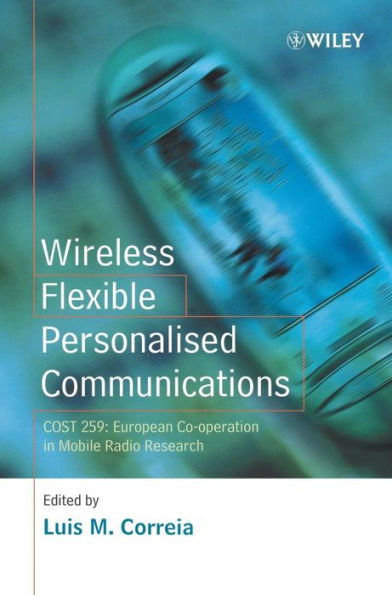Wireless Flexible Personalised Communications
Recent years have witnessed an explosion of new operators and customers of cellular mobile communications and the importance of wireless/mobile communications in today's telecommunications industry is indisputable.
The Final Report of COST 259, 'Wireless Flexible Personalised Communications' is the result of extensive work, performed by more than 200 European researchers from more than 90 institutions (universities and companies) in the area of mobile radio.
—Provides a discussion on the evolution of wireless/mobile communications focusing on the use of data and multimedia, and consequently broadband communications
—Examines the radio systems aspects of future wireless communication systems, concentrating primarily on physical layer issues and including assessments of OFDM and CDMA
—Presents radio propagation and adaptive antennas, and provides a thorough understanding of the mobile radio channel
—Discusses the radio network aspects for the improvement and optimisation of the existing 2G systems and the planning of UMTS/IMT2000
—Explains the design and implementation of UMTS and new techniques for future wireless broadband communication systems
Due to the broad and comprehensive range of topics covered in this book it will appeal not only to engineers working within the GSM industry but also to those involved in UMTS and to researchers working on the next generation of mobile systems.
1102288832
The Final Report of COST 259, 'Wireless Flexible Personalised Communications' is the result of extensive work, performed by more than 200 European researchers from more than 90 institutions (universities and companies) in the area of mobile radio.
—Provides a discussion on the evolution of wireless/mobile communications focusing on the use of data and multimedia, and consequently broadband communications
—Examines the radio systems aspects of future wireless communication systems, concentrating primarily on physical layer issues and including assessments of OFDM and CDMA
—Presents radio propagation and adaptive antennas, and provides a thorough understanding of the mobile radio channel
—Discusses the radio network aspects for the improvement and optimisation of the existing 2G systems and the planning of UMTS/IMT2000
—Explains the design and implementation of UMTS and new techniques for future wireless broadband communication systems
Due to the broad and comprehensive range of topics covered in this book it will appeal not only to engineers working within the GSM industry but also to those involved in UMTS and to researchers working on the next generation of mobile systems.
Wireless Flexible Personalised Communications
Recent years have witnessed an explosion of new operators and customers of cellular mobile communications and the importance of wireless/mobile communications in today's telecommunications industry is indisputable.
The Final Report of COST 259, 'Wireless Flexible Personalised Communications' is the result of extensive work, performed by more than 200 European researchers from more than 90 institutions (universities and companies) in the area of mobile radio.
—Provides a discussion on the evolution of wireless/mobile communications focusing on the use of data and multimedia, and consequently broadband communications
—Examines the radio systems aspects of future wireless communication systems, concentrating primarily on physical layer issues and including assessments of OFDM and CDMA
—Presents radio propagation and adaptive antennas, and provides a thorough understanding of the mobile radio channel
—Discusses the radio network aspects for the improvement and optimisation of the existing 2G systems and the planning of UMTS/IMT2000
—Explains the design and implementation of UMTS and new techniques for future wireless broadband communication systems
Due to the broad and comprehensive range of topics covered in this book it will appeal not only to engineers working within the GSM industry but also to those involved in UMTS and to researchers working on the next generation of mobile systems.
The Final Report of COST 259, 'Wireless Flexible Personalised Communications' is the result of extensive work, performed by more than 200 European researchers from more than 90 institutions (universities and companies) in the area of mobile radio.
—Provides a discussion on the evolution of wireless/mobile communications focusing on the use of data and multimedia, and consequently broadband communications
—Examines the radio systems aspects of future wireless communication systems, concentrating primarily on physical layer issues and including assessments of OFDM and CDMA
—Presents radio propagation and adaptive antennas, and provides a thorough understanding of the mobile radio channel
—Discusses the radio network aspects for the improvement and optimisation of the existing 2G systems and the planning of UMTS/IMT2000
—Explains the design and implementation of UMTS and new techniques for future wireless broadband communication systems
Due to the broad and comprehensive range of topics covered in this book it will appeal not only to engineers working within the GSM industry but also to those involved in UMTS and to researchers working on the next generation of mobile systems.
245.95
In Stock
5
1

Wireless Flexible Personalised Communications
484
Wireless Flexible Personalised Communications
484Hardcover
$245.95
245.95
In Stock

From the B&N Reads Blog
